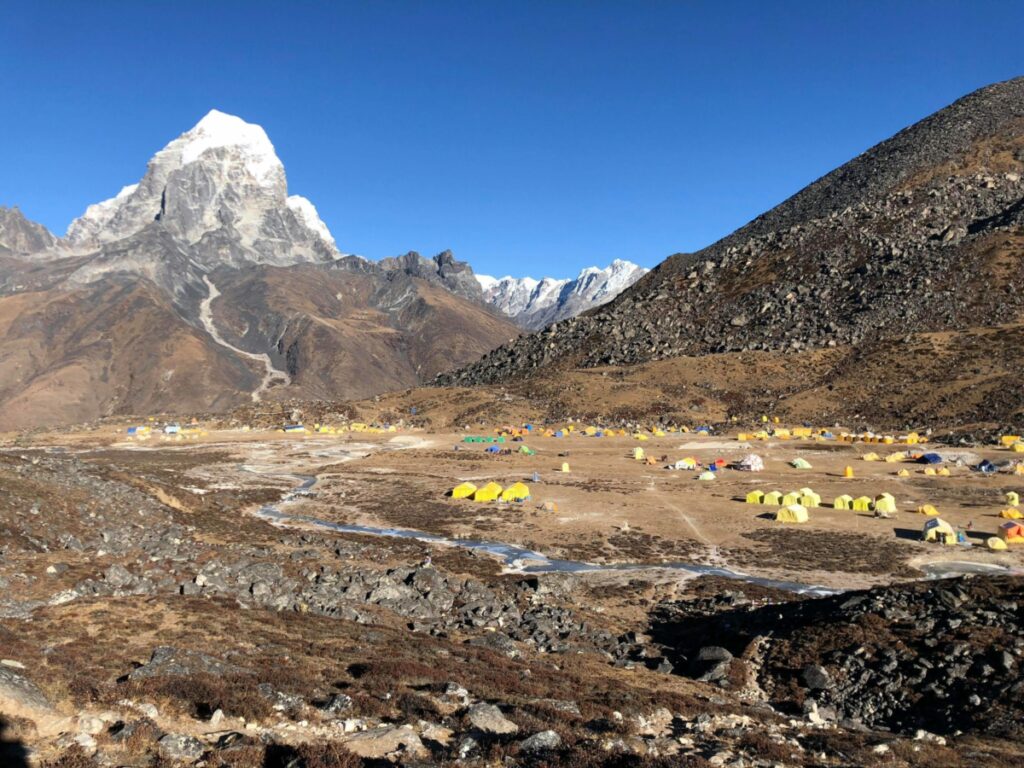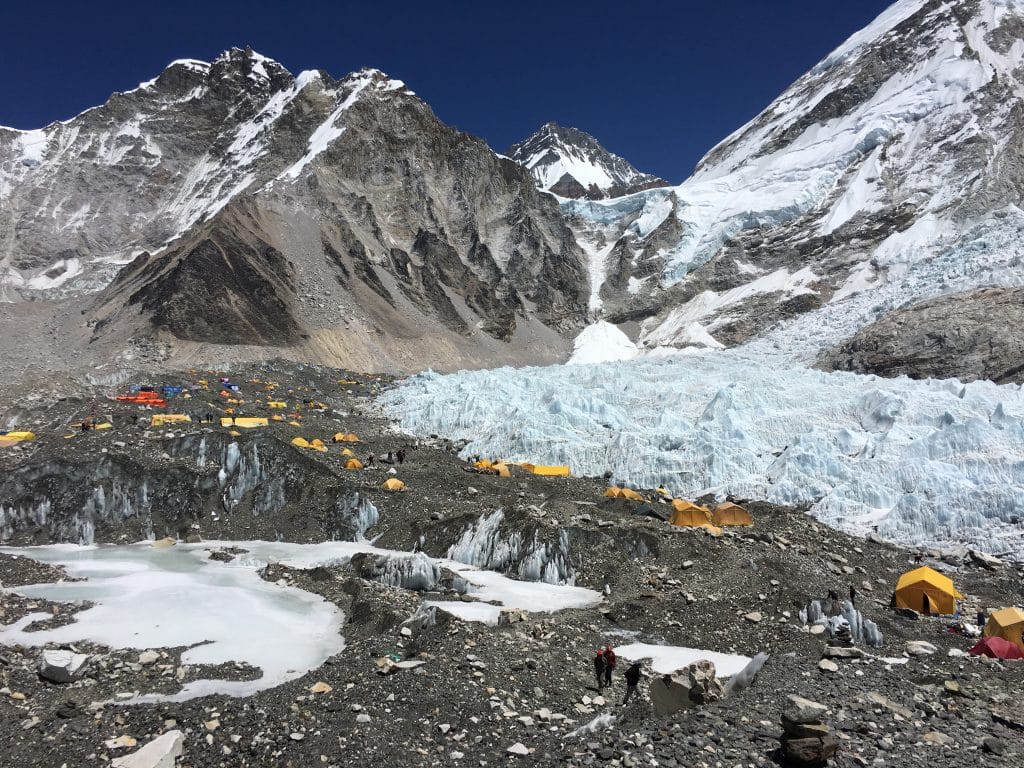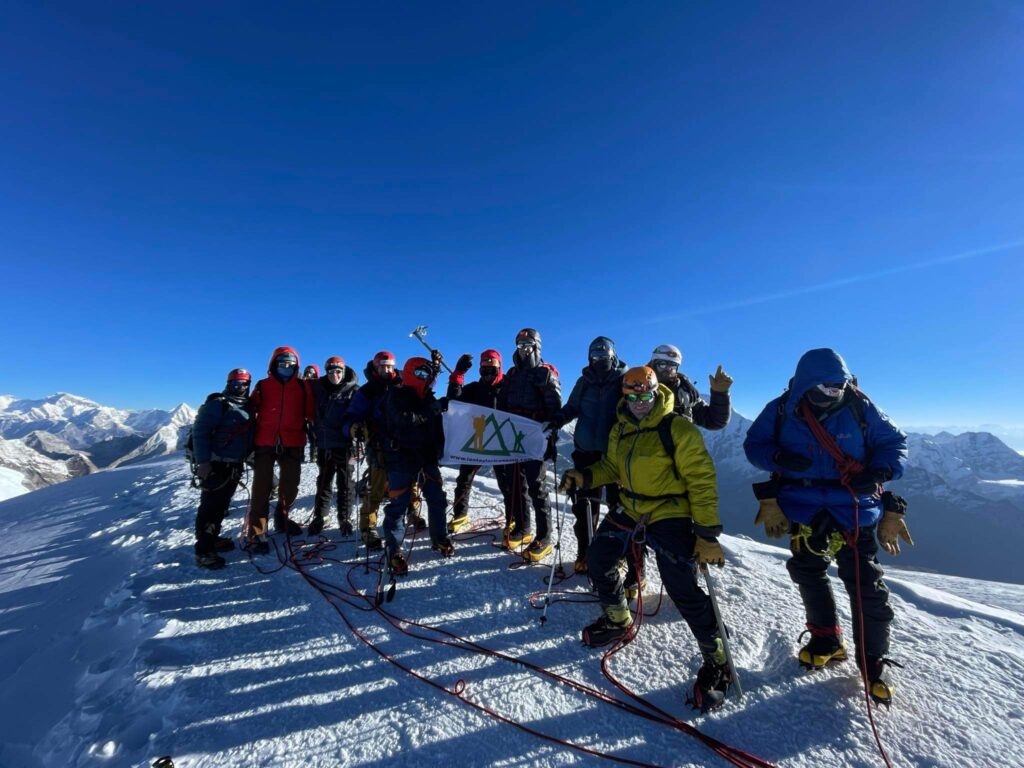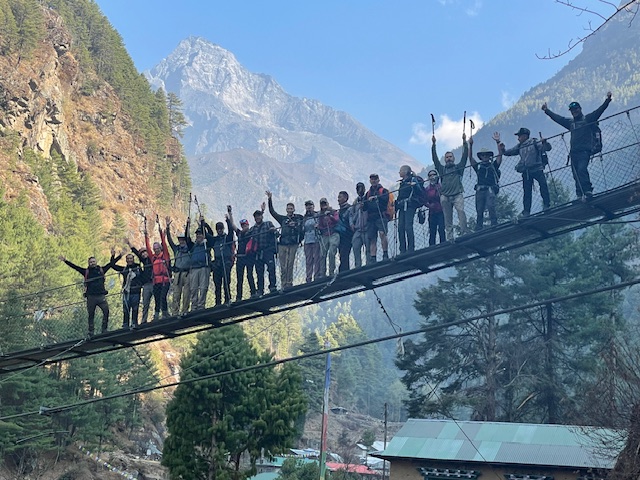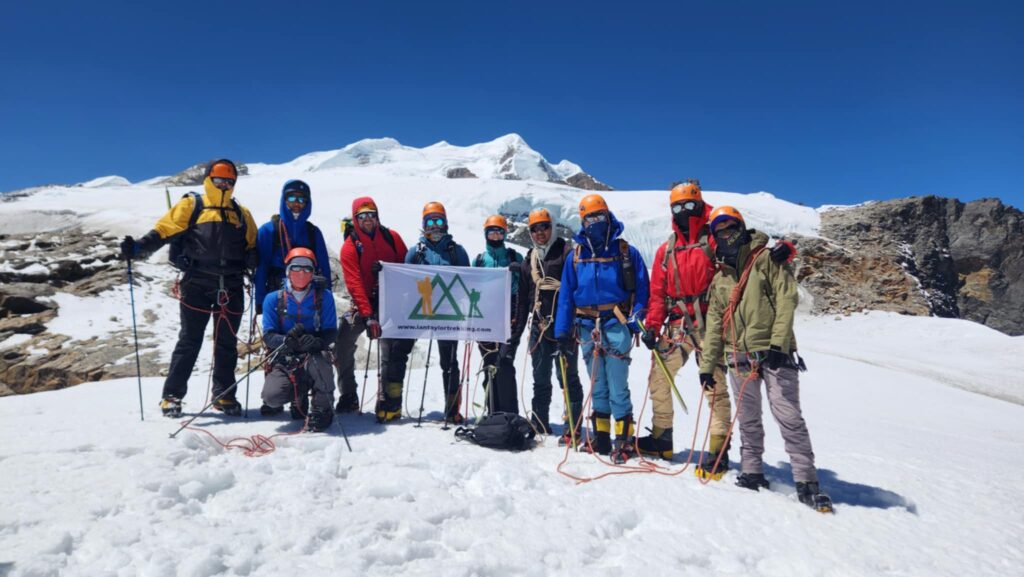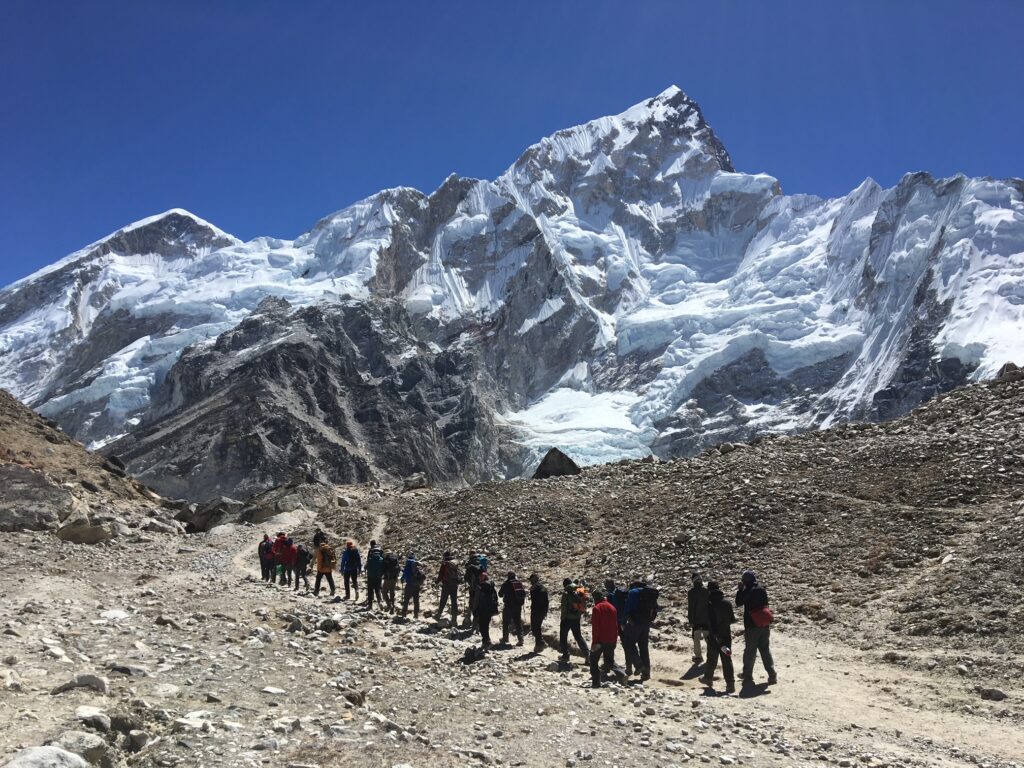
Overview
Trekking to Everest Base Camp and Mera Peak Climb is the ultimate Himalayan adventure.
Looking for the ultimate Himalayan adventure? Our Everest Base Camp and Mera Peak expedition combines two of Nepal’s greatest experiences in one journey. You’ll trek the legendary trail to Everest Base Camp (5,364m / 17,598 ft), standing face to face with the world’s highest mountain, before flying by helicopter to Mera Peak (6,476m / 21,246 ft) for a once-in-a-lifetime summit attempt.
This unique itinerary allows you to experience both classic trekking in the Khumbu region and the thrill of high-altitude mountaineering in one seamless trip. Few expeditions in the world offer such a diverse and rewarding challenge.
Why Trek and Climb with Us?
We specialize in trekking and climbing expeditions in Nepal and won the International Tourism award in 20219. We provide highly experienced guides, top-notch logistics, and personalized support every step of the way. Our teams are focused on safety, preparation, and creating an enjoyable, life-changing adventure.
This trip truly combines the best of trekking and mountaineering: the cultural richness of the Everest Base Camp trek and the exhilarating challenge of summiting Mera Peak.
The Everest Base Camp Trek
Widely regarded as one of the best treks in the world, the Everest Base Camp trek takes you deep into the Khumbu Valley. Along the way, you’ll pass through Sherpa villages, Buddhist monasteries, and dramatic landscapes, all while enjoying breathtaking views of Everest, Lhotse, Ama Dablam, and Nuptse. Spending three nights in Namche Bazaar and other key stops ensures proper acclimatization and a rich cultural experience.
Climbing Mera Peak
At 6,476m / 21,246 ft, Mera Peak is the highest trekking peak in Nepal and a dream for aspiring mountaineers. From its summit, you can see five of the world’s 8,000m giants: Everest, Lhotse, Makalu, Kanchenjunga, and Cho Oyu. With the helicopter transfer, you’ll maximize your time on the mountain, focus on acclimatization and training, and give yourself the best chance to reach the summit safely.
Why Choose This Adventure?
- Incredible Himalayan Experience: Trek through the heart of the Everest region, visiting Namche Bazaar, Tengboche, and Everest Base Camp itself.
- Acclimatization Built for Success: We spend three nights in Namche Bazaar, the Sherpa capital, giving you the best chance to adjust safely to altitude and enjoy the trek.
- Helicopter Transfer to Mera Peak: Skip long, difficult approaches and fly directly to Mera Peak’s region, conserving energy for your summit push.
- Proven Track Record: We’re proud to have a 99% success rate on this combined trek and climb, thanks to expert guides, carefully designed itineraries, and years of experience.
- Double Achievement: Complete the world’s most famous trek and climb one of Nepal’s highest trekking peaks — all in one unforgettable journey.
Upcoming Trips
Itinerary
Day 1
Fly to Kathmandu, Some people may choose to fly in a day early to have an extra day in Kathamandu and this fast paced city. You should aim to arrive on the afternoon, the day before the trek. There are plenty of sights to visit and explore and you can pick up any last minute items on the streets of the Thamel district. Two nights accommodation in Kathmandu is included in the cost of the trip.
Day 2
Fly from Kathmandu to Lukla. We will make an early morning start for the Twin Otter flight to Lukla (2,840m/9,317ft), the gateway to the Khumbu Region. This is an exciting flight, which should give a glimpse of Everest in the distance. In Lukla, we will meet our trek staff and porters and set off straightaway for our first night’s stop at Phakding (2,600m/8,500ft) or continue onto Monjo. Situated on the banks of the Dudh Kosi, which drains the whole of the Khumbu Region, this small hamlet is on the main trade route through the area and there are a number of clean, well-built lodges where we can spend the night.
Day 3
Trek to Namche Bazaar. We will continue up the banks of the Dudh Kosi, crossing it twice by small suspension bridges before reaching the village of Monjo where we will enter the Sagarmatha National Park. We will then cross the confluence of the Dudh Kosi and the Bhote Kosi on a high suspension bridge and climb steeply for about two hours up ‘Namche Hill’ to reach Namche Bazaar (3,440m/11,286ft). This is a prosperous trading town and the capital of the Khumbu Region. Many Tibetans cross the nearby border to trade their wares here, and the local market is a fascinating spectacle. This is a good place to buy genuine Tibetan artifacts. Just across the valley to the east stand the peaks of Thamserku and Kangtega, both very impressive mountains.
Day 4
Today will be used as an acclimatization day as we need to adjust to the low oxygen levels. We will take a hike up to Shangbouche hill (3,900m/12,800ft) with stunning panoramic views of the whole Everest Region. During this critical acclimatization phase, we will spend time resting and trekking to higher altitudes to aid in the process. This will allow our bodies to become acclimatized to the altitude of (3,440m/11,286ft) After this breath taking hike we will returning to Namche for lunch. The afternoon can be spent sampling the delights of the Namche bakery! or playing pool in Cafe Danfe.
Day 5
We will spent as another day in this region. We will made a hike up to a local museum (3,550m/ 11,647ft) or Khunde (3,840m/12,600ft) The museum explains the local culture, Everest and more about the history of the region. This will be vital in giving you the best acclimatization for moving further up into the Everest region and help you safely reach Everest Base Camp. We will spend the afternoon resting and relaxing and enjoy a nice chicken sizzler at the Himalayan lodge.
Day 6
Trek to Tengbouche at (3,900m/12,800ft). From Namche the Everest trail contours around the side of the valley high above the Dudh Kosi. As we follow the path, we will get our first really good views of the great peaks of the Khumbu: Everest, Lhotse, Nuptse and Ama Dablam. We descend down to our lunch stop passing by several small villages and numerous tea shops, we will cross the Dudh Kosi River. After our break we will make the long climb on a dusty zig zag trail. This up hill push will take just over 2 hours. Tengbouche is home of an impressive and recently rebuilt monastery. We have plenty of time to look around Tengbouche (and have a cake at the bakery!). We will stay at a new lodge across from the monastery.
Day 7
Trek to Dingboche. We will make an initial descent down through Rhododendron trees the trail crosses a new suspension bridge just beyond Deboche. An hour’s walking from here will bring us to Pangboche, an excellent viewpoint for Ama Dablam (‘Mother’s Charm Box’) Pangboche was badly damaged in the recent earthquake. Contouring up the valley side, we will re-cross the river and turn up the Imja Valley to reach the picturesque farming village of Dingboche at (4,410m/ 14,465ft). There is an internet cafe, some nice lodges and a new bakery. It is important to keep hydrated and relax for the rest of the day.
Day 8
Today is spent as another acclimatization day. We will make an morning ascent of the ridge which sits behind Dingbouche and we will try and ascend up to (4,900m/ 16,000ft) This acclimatization hike gives us great view of Ama Dablam (6,856m/ 22,495ft), Island Peak (6,189m/ 20,305ft) and Tabuche (6,367m/ 20,890ft) We will descend back to Dingbouche for the afternoon. While in Dingboche, you can attend a seminar about high altitude acclimatization at the hospital in nearby Pheriche (4,200/ 13,780ft) run by the Himalayan Rescue Association. The walk over to Pheriche and back will also serve as good acclimatization training.
Day 9
Trek to Lobuche. We will continue along the trail up on a platform above the valley floor. This will lead us up towards Dugla. Ahead of us is the trekking peak of Lobuje East (6,119m/ 20,075ft), and to our left is the formidable north face of Tabuche, the scene of many cutting-edge Himalayan ascents of the 1980s and 1990s. After three hours we reach the small collection of lodges at Dugla (4,620m/15,153ft). After lunch we continue the walk up the steep hill to the Sherpa memorials, there are outstanding views of Ama Dablam, Cholatse and Tabuche. From Dugla, the trail starts steeply to climb up beside the glacier moraine. After a few hours the trail eventually leads to a small cluster of tea houses pleasantly situated at Lobuche (4,940m/16,207ft).
Day 10
Trek to Gorak Shep. We will start early this morning. About three hours beyond Lobuche we reach Gorak Shep (5,180m/17,126ft), the site of the 1953 Everest Expedition’s base camp. We will be sleeping here tonight on return from Everest Base Camp. We will fill up with more water and continue the famous trail to Everest Base Camp. We will need to be careful as there is a chance of some small rock fall on our left as we move onto the Khumbu Glacier. This is it you will walk the final section into Everest Base Camp, walk around base camp, go to the edge of the Khumbu Ice fall. If you are trekking in from the end of March to May you will meet some of the climbing teams preparing to summit the world’s highest mountain and experience this magical place, before return back to Gorak Shep which may take 2 hours.
Day 11
Today we will make the ascent of Kala Pattar at (5,545m/ 18,188ft) (this can also be done on the day before) It is highly recommended to make an early morning ascent of Kala Phattar for hopefully a stunning sunrise view over Everest. The climb takes between 2 and 3 hours and can be hard work, but the effort is rewarded by the classic view of Everest and the Khumbu Icefall, as well as Lhotse, Nuptse, and Pumori immediately above. This view of Everest will leave you inspired, maybe change your life in simple, small and in ways you never imagined. From the morning summit we will return to Gorak shep, have breakfast and pack your bags and prepare for the helicopter ride to Khare below Mera peak (5,100/ 16,732 ft) The Helicopter will make it’s way back to Lukla, access the weather before flying into Khare in the Hinku valley.
Day 12
This will be a rest day in khare. We will possibly walk up a small hill just outside the village giving you some great views of Mera, the surrounding valley and across the Mera la at (5,400m/ 17,716ft) It is important to rest and relax today and recover the previous exertion getting up to Everest base camp. This is where the camping begins.
Day 13
Today is another acclimatization and rest day in Khare (5,100m/ 17,716ft). We will spend the morning getting our climbing gear sorted. We will rig up a climbing scenario and practice using crampons, Jumars, abseiling and we will practice until you are comfortable doing all the different techniques. We will rest up and enjoy this amazing mountain setting.
Day 14
Today we will make the move from Khare to Mera Base Camp (5,300m/ 17,388ft) today we climb up to the Mera La (5,400m/ 17,717ft). We will climb up to the Mera Glacier. At first it is easy but the trek up to the glacier is steep in sections and you will need to pace yourself and make sure you are getting your foot placements correctly. There is a chance of rock fall so wearing helmets, crampons is needed. The walk across the glacier is outstanding, with views and memories you will never forget. The descent from the glacier to the campsite is short. We walk between the moraine and the glacier on the northern side as it descends from the col down to the campsite which you can easily see from the glacier.
Day 15
We will ascend to Mera High Camp (5,800m/19,029ft). We head back up onto the glacier to where we dropped off yesterday and follow the easy graded snow slopes, and after a short distance arrive at an area of crevasses which we will have to navigate carefully. We then make are way slowly up to High camp. Remember to look behind you where you will see views of Everest, Makalu, Nuptse and Lhotse and this trek up to high camp holds some Himalayan treasures. This camp is hidden behind a rocky section. The camp site is small and has some drop offs on the right as you enter the camp. It is time to rehydrate and recover for summit push.
Day 16
The climb to the summit of Mera Peak starts gradually, and much depends on weather conditions. Once we leave high camp usually at 2am it should take 6 hours to reach the summit. Getting into a rest step and taking our time will be critical to conserving energy for the decent. The central summit appears above the wide glacier, flanked by 2 ridges. We climb the snowfields avoiding the crevasses. This steep section can take 2 hours and is slow going. The route swings to the east of the left hand ridge before turning back towards the main summit ridge of Mera. Mera has 3 summits, our objective is the highest. This final short steep snow slope is easily climbed, but the last 50m/164ft requires a lot of effort, Jumaring on a short steep ice section and you arrive on the summit. After reaching the summit and enjoying amazing views over the Himalayas, we have a short abseil before the long descent back to High camp. We will rest for one hour, back up your kit before descending back down to Khare at (5,100m/ 16,732ft)
Day 17
Today is a spare day for a second summit attempt. We might need this due to the weather conditions. Mera can have high winds and deep snow so having this extra day gives you another chance at making the summit of Mera peak.
Day 18
We will make our way back to Lukla on a different route to the one we came in. This will take four days.
Day 19
We will make our way back to Lukla on a different route to the one we came in. This will take four days.
Day 20
We will make our way back to Lukla on a different route to the one we came in. This will take four days.
Day 21
We will make our way back to Lukla on a different route to the one we came in. This will take four days.
Day 22
We will be up early for our morning flight back to Kathmandu, shower change and head out to finish off your Kathmandu sightseeing. You can either fly home this evening or spend another day in Kathmandu. We also cover one nights accommodation in Kathmandu at the end of the trip.
Day 23
Pick up some last minute items, spend the afternoon at the Kathmandu Spa and prepare for your flight home or onward journey.
Map
Reviews
Country:
Nepal
Duration:
21 Days
Distance:
0,0 km
Max. Altitude:
6,476m / 21,246ft
Difficulty:
Very Challenging
Group Size:
4
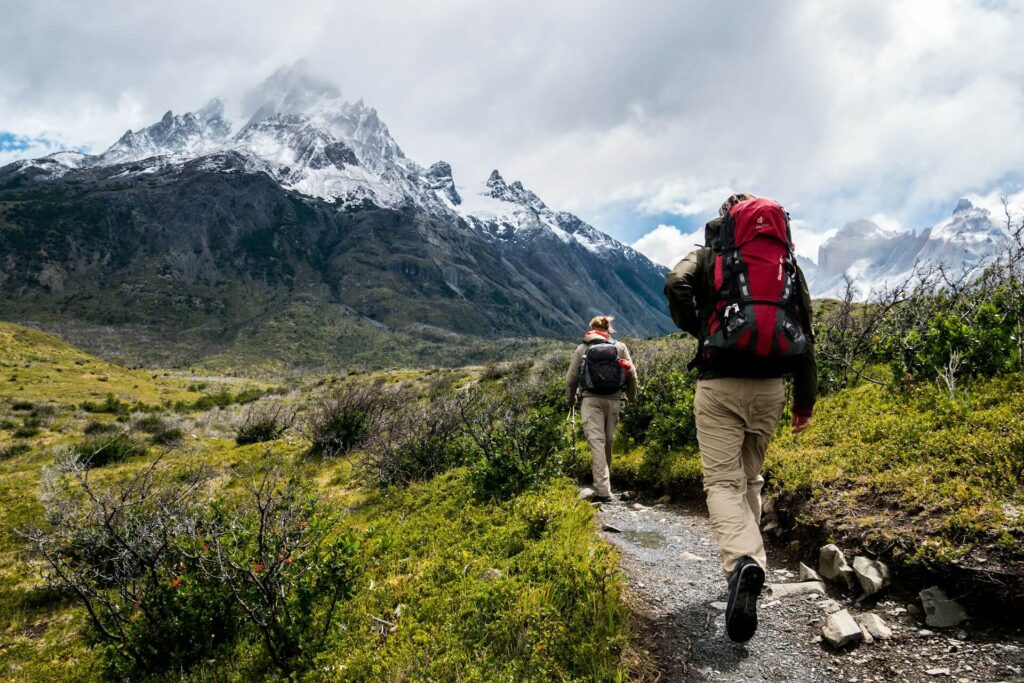
Ready to go?
Does this information on Everest base camp and Mera peak climb excite you? Take the next step towards achieving your goals of reaching Everest Base Camp and climbing Mera peak. If so, get in touch today.
Similar Treks

